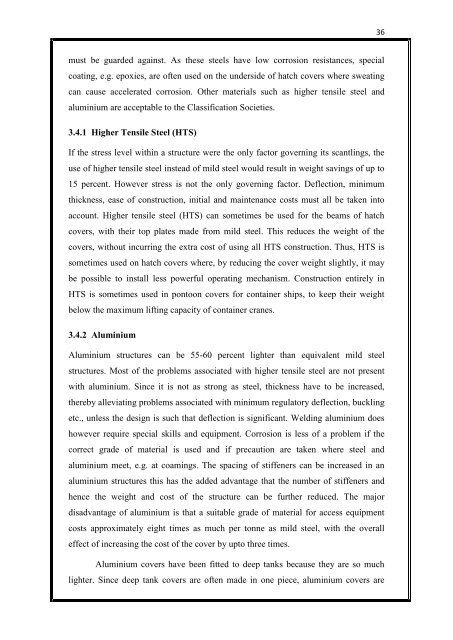Single pull macgregor type hatch cover.pdf - Cochin University of ...
Single pull macgregor type hatch cover.pdf - Cochin University of ...
Single pull macgregor type hatch cover.pdf - Cochin University of ...
You also want an ePaper? Increase the reach of your titles
YUMPU automatically turns print PDFs into web optimized ePapers that Google loves.
must be guarded against. As these steels have low corrosion resistances, special<br />
coating, e.g. epoxies, are <strong>of</strong>ten used on the underside <strong>of</strong> <strong>hatch</strong> <strong>cover</strong>s where sweating<br />
can cause accelerated corrosion. Other materials such as higher tensile steel and<br />
aluminium are acceptable to the Classification Societies.<br />
3.4.1 Higher Tensile Steel (HTS)<br />
If the stress level within a structure were the only factor governing its scantlings, the<br />
use <strong>of</strong> higher tensile steel instead <strong>of</strong> mild steel would result in weight savings <strong>of</strong> up to<br />
15 percent. However stress is not the only governing factor. Deflection, minimum<br />
thickness, ease <strong>of</strong> construction, initial and maintenance costs must all be taken into<br />
account. Higher tensile steel (HTS) can sometimes be used for the beams <strong>of</strong> <strong>hatch</strong><br />
<strong>cover</strong>s, with their top plates made from mild steel. This reduces the weight <strong>of</strong> the<br />
<strong>cover</strong>s, without incurring the extra cost <strong>of</strong> using all HTS construction. Thus, HTS is<br />
sometimes used on <strong>hatch</strong> <strong>cover</strong>s where, by reducing the <strong>cover</strong> weight slightly, it may<br />
be possible to install less powerful operating mechanism. Construction entirely in<br />
HTS is sometimes used in pontoon <strong>cover</strong>s for container ships, to keep their weight<br />
below the maximum lifting capacity <strong>of</strong> container cranes.<br />
3.4.2 Aluminium<br />
Aluminium structures can be 55-60 percent lighter than equivalent mild steel<br />
structures. Most <strong>of</strong> the problems associated with higher tensile steel are not present<br />
with aluminium. Since it is not as strong as steel, thickness have to be increased,<br />
thereby alleviating problems associated with minimum regulatory deflection, buckling<br />
etc., unless the design is such that deflection is significant. Welding aluminium does<br />
however require special skills and equipment. Corrosion is less <strong>of</strong> a problem if the<br />
correct grade <strong>of</strong> material is used and if precaution are taken where steel and<br />
aluminium meet, e.g. at coamings. The spacing <strong>of</strong> stiffeners can be increased in an<br />
aluminium structures this has the added advantage that the number <strong>of</strong> stiffeners and<br />
hence the weight and cost <strong>of</strong> the structure can be further reduced. The major<br />
disadvantage <strong>of</strong> aluminium is that a suitable grade <strong>of</strong> material for access equipment<br />
costs approximately eight times as much per tonne as mild steel, with the overall<br />
effect <strong>of</strong> increasing the cost <strong>of</strong> the <strong>cover</strong> by upto three times.<br />
Aluminium <strong>cover</strong>s have been fitted to deep tanks because they are so much<br />
lighter. Since deep tank <strong>cover</strong>s are <strong>of</strong>ten made in one piece, aluminium <strong>cover</strong>s are<br />
36

















